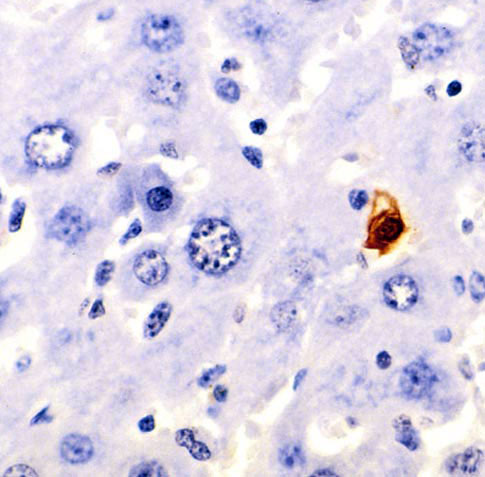TUNEL assay on:
[Wikipedia]
[Google]
[Amazon]
 Terminal deoxynucleotidyl transferase dUTP nick end labeling (TUNEL) is a method for detecting
Terminal deoxynucleotidyl transferase dUTP nick end labeling (TUNEL) is a method for detecting
 Terminal deoxynucleotidyl transferase dUTP nick end labeling (TUNEL) is a method for detecting
Terminal deoxynucleotidyl transferase dUTP nick end labeling (TUNEL) is a method for detecting DNA fragmentation
DNA fragmentation is the separation or breaking of DNA strands into pieces. It can be done intentionally by laboratory personnel or by cells, or can occur spontaneously. Spontaneous or accidental DNA fragmentation is fragmentation that gradually a ...
by labeling the 3′- hydroxyl termini in the double-strand DNA breaks generated during apoptosis
Apoptosis (from grc, ἀπόπτωσις, apóptōsis, 'falling off') is a form of programmed cell death that occurs in multicellular organisms. Biochemical events lead to characteristic cell changes ( morphology) and death. These changes in ...
.
Method
TUNEL is a method for detectingapoptotic
Apoptosis (from grc, ἀπόπτωσις, apóptōsis, 'falling off') is a form of programmed cell death that occurs in multicellular organisms. Biochemical events lead to characteristic cell changes ( morphology) and death. These changes incl ...
DNA fragmentation, widely used to identify and quantify apoptotic cells, or to detect excessive DNA breakage in individual cells. The assay
An assay is an investigative (analytic) procedure in laboratory medicine, mining, pharmacology, environmental biology and molecular biology for qualitatively assessing or quantitatively measuring the presence, amount, or functional activity of ...
relies on the use of terminal deoxynucleotidyl transferase (TdT), an enzyme
Enzymes () are proteins that act as biological catalysts by accelerating chemical reactions. The molecules upon which enzymes may act are called substrates, and the enzyme converts the substrates into different molecules known as products ...
that catalyzes attachment of deoxynucleotides, tagged with a fluorochrome or another marker, to 3'-hydroxyl termini of DNA double strand breaks. It may also label cells having DNA damaged by other means than in the course of apoptosis.
History
The fluorochrome-based TUNEL assay applicable forflow cytometry
Flow cytometry (FC) is a technique used to detect and measure physical and chemical characteristics of a population of cells or particles.
In this process, a sample containing cells or particles is suspended in a fluid and injected into the flow ...
, combining the detection of DNA strand breaks with respect to the cell cycle
The cell cycle, or cell-division cycle, is the series of events that take place in a cell that cause it to divide into two daughter cells. These events include the duplication of its DNA (DNA replication) and some of its organelles, and sub ...
-phase position, was originally developed by Gorczyca et al. Concurrently, the avidin-peroxidase labeling assay applicable for light absorption microscope was described by Gavrieli et al. Since 1992 the TUNEL has become one of the main methods for detecting apoptotic programmed cell death. However, for years there has been a debate about its accuracy, due to problems in the original assay which caused necrotic
Necrosis () is a form of cell injury which results in the premature death of cells in living tissue by autolysis. Necrosis is caused by factors external to the cell or tissue, such as infection, or trauma which result in the unregulated dige ...
cells to be inappropriately labeled as apoptotic. The method has subsequently been improved dramatically and if performed correctly should only identify cells in the last phase of apoptosis
Apoptosis (from grc, ἀπόπτωσις, apóptōsis, 'falling off') is a form of programmed cell death that occurs in multicellular organisms. Biochemical events lead to characteristic cell changes ( morphology) and death. These changes in ...
. New methods incorporate the dUTPs modified by fluorophores or haptens, including biotin
Biotin (or vitamin B7) is one of the B vitamins. It is involved in a wide range of metabolic processes, both in humans and in other organisms, primarily related to the utilization of fats, carbohydrates, and amino acids. The name ''biotin'', bo ...
or bromine
Bromine is a chemical element with the symbol Br and atomic number 35. It is the third-lightest element in group 17 of the periodic table ( halogens) and is a volatile red-brown liquid at room temperature that evaporates readily to form a simi ...
, which can be detected directly in the case of a fluorescently-modified nucleotide
Nucleotides are organic molecules consisting of a nucleoside and a phosphate. They serve as monomeric units of the nucleic acid polymers – deoxyribonucleic acid (DNA) and ribonucleic acid (RNA), both of which are essential biomolecu ...
(i.e., fluorescein-dUTP), or indirectly with streptavidin or antibodies
An antibody (Ab), also known as an immunoglobulin (Ig), is a large, Y-shaped protein used by the immune system to identify and neutralize foreign objects such as pathogenic bacteria and viruses. The antibody recognizes a unique molecule of ...
, if biotin-dUTP or BrdUTP are used, respectively. The most sensitive of them is the method utilizing incorporation of BrdUTP by TdT followed by immunocytochemical detection of BrdU
Bromodeoxyuridine (5-bromo-2'-deoxyuridine, BrdU, BUdR, BrdUrd, broxuridine) is a synthetic nucleoside analogue with a chemical structure similar to thymidine. BrdU is commonly used to study cell proliferation in living tissues and has been stud ...
.
References
External links
* {{DEFAULTSORT:Tunel Assay Laboratory techniques Programmed cell death